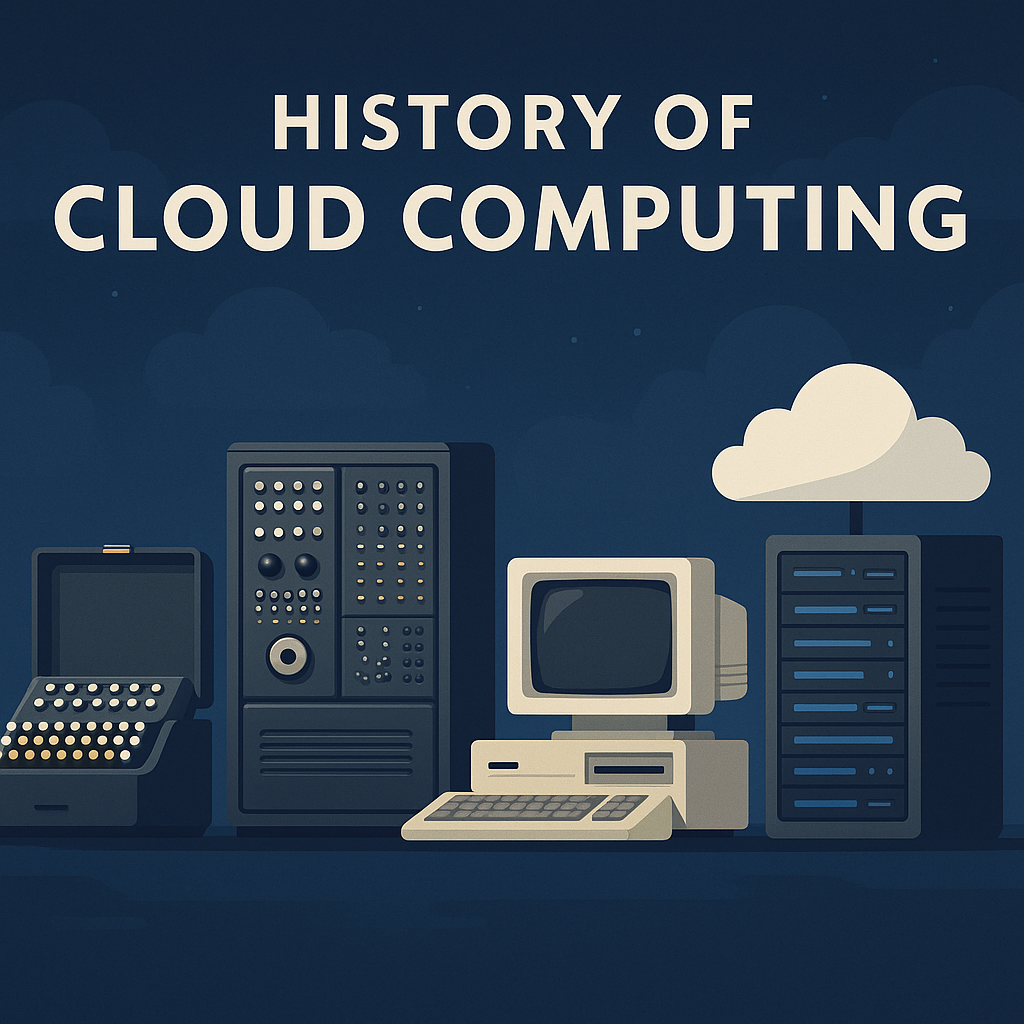The history of cloud computing offers a broad and detailed overview of the key milestones in the development of this technology. While not exhaustive, it provides an interpretation of innovation as a driving force.
Table of Contents
The History of Cloud Computing
Understanding the evolution of cloud computing is essential for grasping its impact on modern business practices. The development of this technology not only reflects advancements in computer science but also parallels changes in user expectations and the digital economy. Each phase in the timeline of cloud computing reveals how technology adapts to meet the growing demands for efficiency, flexibility, and scalability.
For instance, during the introduction of time-sharing systems, businesses began to recognize the benefits of resource sharing and centralized processing. This was a pivotal moment, as it set the stage for later developments in cloud infrastructure.
This evolution can be further illustrated by the rise of personal computing in the 1980s, which changed how organizations thought about computing resources and accessibility.
The period from 1995 to 2000 saw the emergence of the first cloud providers, highlighting the shift from traditional IT models to more dynamic, service-oriented approaches. Companies like Salesforce not only changed the sales software landscape but also demonstrated the viability of delivering enterprise applications via the internet.
Moreover, the introduction of Amazon Web Services (AWS) in 2006 marked a significant milestone in cloud computing, as it paved the way for other companies to develop their cloud offerings and shifted the market towards a service-oriented architecture.
By formally defining cloud computing, NIST helped standardize services in the industry, which fostered greater interoperability and trust between providers and consumers alike.
The era of maturity from 2010 to 2020 further solidified cloud computing’s presence in the enterprise with innovations like Kubernetes, which enabled companies to manage and deploy microservices efficiently.
The history of cloud computing offers a broad and detailed overview of the key milestones in the development of this technology. While not exhaustive, it provides an interpretation of innovation as a driving force. Cloud computing has evolved significantly over the decades, with various pioneers, technological advancements, and market shifts shaping its current landscape. As we delve deeper into the history of this transformative technology, we will explore its origins, key players, and the innovations that have propelled it into the mainstream.
As organizations increasingly adopted hybrid cloud strategies, they were able to leverage both public and private cloud resources, optimizing their operational efficiency and leading to new business models.
We can divide this history into distinct periods:
- Precursors to Cloud Computing (1960s–1980s)
- The First Cloud Providers (1995–2000)
- The Era of Maturity (2010–2020)
- The AI Era (Post-2020)
Precursors to Cloud Computing (1960s–1980s)
Time-Sharing and Mainframes : Introduced in the 1960s, time-sharing represented a breakthrough in resource sharing, allowing multiple users to access a centralized mainframe. This model laid the foundation for modern cloud computing.
Virtual Machines (VMs) : In the 1970s, IBM developed the first versions of virtual machines, enabling the creation of multiple independent environments on a single physical hardware system.
The Network and Virtualization Era (1990s)
VPNs and Hosting : Telecommunications companies began offering Virtual Private Networks (VPNs) to improve network efficiency. At the same time, providers like GoDaddy started offering web hosting services.
The Term “Cloud” : Coined in 1997 by Ramnath K. Chellappa, “cloud computing” was introduced to describe a computing model defined more by economic logic than by technological constraints.
The First Cloud Providers (1995–2000)
Rackspace and Salesforce : During this period, pioneers like Rackspace and Salesforce entered the market, laying the groundwork for cloud service models.
Amazon Web Services (AWS) : AWS revolutionized the market in 2006 with services like S3 (Simple Storage Service) and EC2 (Elastic Compute Cloud), introducing the pay-as-you-go model.
Google App Engine : In 2008, Google entered the market with a PaaS (Platform as a Service) offering tailored to developers.
Microsoft Azure : In 2010, Microsoft launched Azure, initially focused on PaaS but later expanding to include IaaS (Infrastructure as a Service).
The Cloud Becomes Standardized (2011)
NIST Definition of Cloud Computing : The National Institute of Standards and Technology (NIST) published document 800-145, officially defining service models (IaaS, PaaS, SaaS) and essential cloud characteristics.
The Era of Maturity (2010–2020)
Kubernetes and Container Orchestration : With the launch of Kubernetes in 2014, supported by the CNCF (Cloud Native Computing Foundation), cloud-native became a standard model for deploying scalable applications.
Hybrid and Multi-Cloud Models : Companies like IBM and VMware promoted hybrid and multi-cloud approaches, enabling organizations to combine public and private cloud resources.
The AI Era (Post-2020)
AI Integration : The integration of artificial intelligence into the cloud (e.g., Amazon SageMaker, Google Vertex AI, Microsoft OpenAI) has significantly expanded the capabilities of cloud platforms.
From Cloud Foundations to Intelligent Horizons
The story of cloud computing has always been one of adaptation, resilience, and innovation. As we continue to explore this journey, it is essential to note how the rise of artificial intelligence reshapes the very fabric of digital ecosystems. The fusion of these technologies is not merely about improving efficiency; it challenges existing paradigms and introduces new dynamics that will inevitably transform how cloud services are designed, delivered, and experienced. This evolution raises questions that reach far beyond technology itself, encompassing ethics, governance, and the future of work.
The AI Era (Post-2020) signifies a convergence of cloud computing and artificial intelligence, where companies are now using cloud platforms not just for storage but for sophisticated analytics, machine learning, and automation. This integration enables businesses to make data-driven decisions faster than ever before.
The History of Cloud Computing has profound implications for today’s businesses, allowing them to scale operations, innovate faster, and respond to market changes with unprecedented agility. By learning from the past, organizations can prepare for future advancements and leverage cloud technology to its fullest potential.
References
This article is an excerpt from the book
Cloud-Native Ecosystems
A Living Link — Technology, Organization, and Innovation
